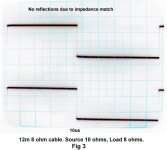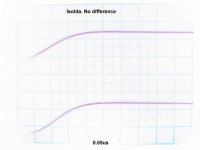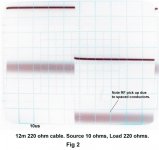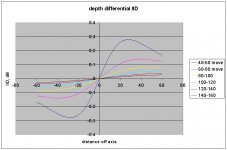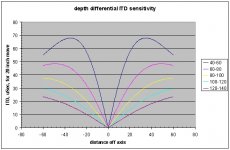The theory of the reflexion of electrons on line extremities witch makes you able to build an echo chamber with only 5 meters of cables.
Lets see you build it. Before digi proccesing studios only had tape delays, you could have been rich!
So you need 100mhz scope to see effects in under 20khz signals? That should be a red flag.
Actually, if the load impedance is grossly lower than the line impedance, a sound card is useable. Just filter the slew rate of the steps out to prevent "crowding" the card with hf ailiasing garbage.
Why a higher than line load was selected defies understanding.
Cheers, John
One of my favorite letters to the editor in the IEEE Spectrum magazine was about the US national power grid. My memory says it was basically, "If the 1/2 wavelength of 60 cycles is 1550 miles, how can any power be transmitted across the country?"
Measurements of impedance (miss)matched cable
The first and second pictures is of Isolda terminated with 8 ohms and the third is DNM cable terminated with 220 ohms.
Re the oft repeated 20-20kHz as the audio band, that is for low-fi.
Hi-Fi requires a bandwidth of at least 10Hz to 80kHz to be at all credible these days (192/24) or, at a pinch, 15Hz to 50kHz (SACD, LP, 96/24).
see
There's life above 20 kilohertz! A survey of musical instrument spectra to 102.4 kHz
for why.
No Hi Fi yet sounds like the band is REALLY there. EVERYTHING in the recording and replay chain must be taken into consideration.
The first and second pictures is of Isolda terminated with 8 ohms and the third is DNM cable terminated with 220 ohms.
Re the oft repeated 20-20kHz as the audio band, that is for low-fi.
Hi-Fi requires a bandwidth of at least 10Hz to 80kHz to be at all credible these days (192/24) or, at a pinch, 15Hz to 50kHz (SACD, LP, 96/24).
see
There's life above 20 kilohertz! A survey of musical instrument spectra to 102.4 kHz
for why.
No Hi Fi yet sounds like the band is REALLY there. EVERYTHING in the recording and replay chain must be taken into consideration.
Attachments
Arn't all Speaker cables RLC circuits , so there will be a difference and the difference will vary from amp/speaker combo...
The first and second pictures is of Isolda terminated with 8 ohms and the third is DNM cable terminated with 220 ohms.
Re the oft repeated 20-20kHz as the audio band, that is for low-fi.
Hi-Fi requires a bandwidth of at least 10Hz to 80kHz to be at all credible these days (192/24) or, at a pinch, 15Hz to 50kHz (SACD, LP, 96/24).
see
There's life above 20 kilohertz! A survey of musical instrument spectra to 102.4 kHz
for why.
No Hi Fi yet sounds like the band is REALLY there. EVERYTHING in the recording and replay chain must be taken into consideration.
The audibility of sounds above 20k is not realistic. Sorry.
You require a better argument than that. Try load variation of impedance vs frequency, ITD, and localization. Soundstage issues..
Simple rolloff of hf is not a valid argument.
Cheers, John
Agreed.On the speaker point of view, the only interesting thing is Current.
As long as it stays in the audio frequencies domain. Read and argue the previous, please. Please, learn (or consider) acoustic and mechanic material.
That was the sens of my (i agree ) bad joke.
Clearly there is a language difference between us. Please do not take offense, I mean none.
I have considered acoustic and mechanical material.
I understand the limitations of a cableset of high impedance driving a low impedance load.
I understand the T line theory quite well.
I understand human localization, and how low microsecond interaural delays can drive a change in image positioning.
I understand what the current within a voice coil will be far more than most.
I understand how the load impedance will alter the settling time (therefore the interaural delay) vs frequency for a speaker load.
That has been why I enjoy what I've been reading.
ps. My expectation is that this discussion will never approach a differential analysis understanding of image placement, nor the overall system requirements necessary to place an image at a location in space to a foot or so. Crawl first, then walk, then run..
I do not expect understanding of these graphs.
Cheers, John
Attachments
Last edited:
I do not totaly agree.The audibility of sounds above 20k is not realistic. Sorry
Slewrate matters, even at 20 000 hz, as an exemple, because it change the amount of *energy* applied to the loudspeaker (high slew rate increase surface of the square wave).
Same meaning than in my previous answer to you.
On the contrary, you can add as much of symetric waves you want at 200kz without major changes in the way the moving coil will accelerate, because inertia: Energy will dissipate in heat. Heat can change your sound as it increase impedance of the coil, for sure. But you need a BIG hf signal.
Again, think D amps.
I thing you and i, despite different native language, are on the same length wave ;-)
Last edited:
Max, I'm interested in the name "Isolda". Any relation to the old Japanese multi-metal Isoda cables? Based on or related to such?
I do not totaly agree.
Slewrate matters, even at 20 000 hz, as an exemple, because it change the amount of *energy* applied to the loudspeaker (high slew rate increase surface of the square wave).
While you are correct in theory, you must consider the integral of the area under the slew if you are actually going to discuss energy in joules.
And don't forget, you are discussing a voice coil in a magnetic gap, driving a time varying field into a solid or laminated iron high permeability path. The decrease in Ls and consequent increase in RS as a result of the core reactances (eddy currents in the iron), totally strip the high slew from consideration as the coil unloads.
ARRRRRGH....GEEK HUMOR!!!! 😀😀I thing you and i, despite different native language, are on the same length wave ;-)
Cheers, John
Last edited:
Lets see you build it. Before digi proccesing studios only had tape delays, you could have been rich!
He was joking. Very nice snark, IMO. 😀
John, are you considering that the driving impedance is near zero?
You know, man, like you, i really enjoy this thread. Dead flies everywhere ;-)While you are correct in theory, you must consider the integral of the area under the slew if you are actually going to discuss energy in joules.
Now we have to consider the demagnetization of the ferrite because temperature increase with hf.
Last edited:
For the settling time, yes. Anything other than that will slow the system response.John, are you considering that the driving impedance is near zero?
On the load side, anything other than a pure resistance will also slow the system response.
So, my analysis can only provide the fastest possible response.
Tomorrow, I will have to try to figure this out..our sense of humors are not in sync yet..You know, man, like you, i really enjoy this thread. Dead flies everywhere ;-)
ah...you edited.
No, I was not discussing the change in temperature of the magnetic path of the driver structure. Only the series inductance and series resistance of the electrical analogue. The magnetic structure fights the slew, and does so by increasing its resistive losses.
Cheers, John
You make-me remember something.He was joking.
We had made as a joke on an album, during the seventies, an echo effect with two phone calls between studios, one in France, one in a friend's one in LA. Just a 600/600 transformer (with isolation electrolytics capacitors) on his side between the two lines. Quite a delay !
The sound was not fantastic in the trebles. I suppose because the capacitors ?
Last edited:
Re the oft repeated 20-20kHz as the audio band, that is for low-fi.
Hi-Fi requires a bandwidth of at least 10Hz to 80kHz to be at all credible these days (192/24) or, at a pinch, 15Hz to 50kHz (SACD, LP, 96/24).
see
There's life above 20 kilohertz! A survey of musical instrument spectra to 102.4 kHz
Just because there is energy above 20khz dosnt prove you can hear a difference. (higher sampling rates sounding better dosnt mean the extra BW is the factor)
No Hi Fi yet sounds like the band is REALLY there. EVERYTHING in the recording and replay chain must be taken into consideration.
Not if dosnt make any difference. And you have no proof that "EVERYTHING in the recording and replay chain" makes a difference. But anecdotal evidence is all you need to sell cables so it keeps coming.
It refers to a French expression. Something in connection with sexual relationships with flies. (Witch means loosing time with insignificant details).Tomorrow, I will have to try to figure this out..our sense of humors are not in sync yet..
Pure perversity, on my side... to literally translate typical expressions like "Appuyer sur le champignon" -> "Push the mushroom".
It works symmetrical too.
That-s all the beauty of this thread. May i add this sampling question to my list of trolls ?higher sampling rates sounding better dosnt mean the extra BW is the factor.
Last edited:
Why oh why is it anyone would assume that one needs nanosecond risetimes to have reflections on a two meter cable??
I think it was I who said transmission line theory is always applicable. The idea of seeing and resolving the steps requires fast risetimes. A 30ns period implies no frequency components under ~33MHz. The stimulus shown in those plots is hopelessly unrealistic in audio.
Yes, the only way to a gradual buildup in this context is if the load and source are less than Zo. Most realistic text book examples reach 1% of final value in < 10 cycles. The "Q" implied by sustained visible 200 reflections is unrealistic for any cable I know of. The dispersion in 2 kilometers of RG58 is considerable.
Last edited:
Just as a curiosity. what is the noise floor (db)? has one been agreed on? or...is everyone just looking at scopes?
I could see two octave above average human hearing would be relevant. (60Khz) assuming energy levels are adequate to manipulate waves in audible range.
edit: pertaining to reflections in line.
back to pop-corn
I could see two octave above average human hearing would be relevant. (60Khz) assuming energy levels are adequate to manipulate waves in audible range.
edit: pertaining to reflections in line.
back to pop-corn
Last edited:
Max, I'm interested in the name "Isolda". Any relation to the old Japanese multi-metal Isoda cables? Based on or related to such?
I sold a....😉
I see a lot of "Spherical cow" logic here. I am interested but confused, not by the data but by the logic.
please enlighten 🙂
edit: why use square waves? complex signal reflections cannot be simulated this way...
square waves in digital communications, yes. audio, no. drivers act as a smoothing filter...
please enlighten 🙂
edit: why use square waves? complex signal reflections cannot be simulated this way...
square waves in digital communications, yes. audio, no. drivers act as a smoothing filter...
Last edited:
- Status
- Not open for further replies.
- Home
- General Interest
- Everything Else
- speaker cable myths and facts
